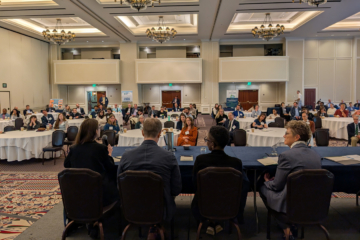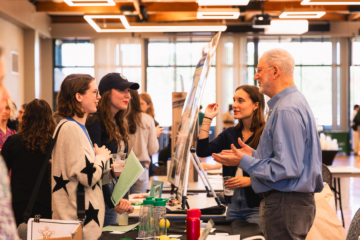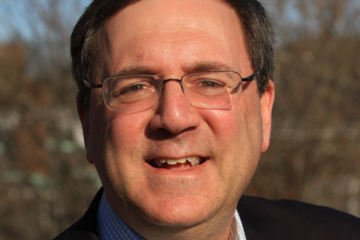W&M’s cross-university environmental initiative hosts inaugural conference
The Virginia Coastal Resilience Collaborative (VCRC) at William & Mary set out with the mission of gathering important voices from community, academic and government partners across the Commonwealth of Virginia and beyond to promote and enable scientifically informed, participatory decision-making for resilience finance.
Vital steps towards this goal took place at their inaugural conference, “Securing Virginia’s Future: National Perspectives on State & Local Resilience Finance,” in Williamsburg, Virginia, on Oct. 3, 2025.
W&M Assistant Provost for Coastal Resilience and VCRC Director Thomas Ruppert hosted the conference in collaboration with the Environmental Defense Fund, Old Dominion University’s Institute for Coastal Adaptation & Resilience, W&M’s Batten School of Coastal & Marine Sciences & VIMS, the University of Virginia’s Institute for Engagement and Negotiation and Virginia Tech’s Coastal Collaborator.
The day started with an introduction from Ruppert and was followed by an engaging fireside chat with Alice Hill, senior fellow for energy and the environment with the Council on Foreign Relations, which was moderated by Samantha (Sam) Medlock. One key message from Alice Hill to local governments was to immediately seek out bond financing in the market now before the capital markets fully integrate rising risk, increasing local government borrowing costs.
Sam Medlock, a climate resilience & disaster preparedness consultant and former assistant administrator for resilience strategy at the Federal Emergency Management Agency (FEMA), also moderated the morning panel on local government resilience finance, insurance and multi-sector collaboration.
This panel featured Ann Phillips, retired United States Navy rear admiral who served as the administrator of the United States Maritime Administration from 2022 to 2025; Tallant (Talley) Burley, manager of climate risk & insurance at the Environmental Defense Fund; Manuela Ekowo, public policy associate with the Insurance Institute for Business & Home Safety; and Matt Posner, head of public finance with The Resiliency Company.
The morning panel highlighted many important risk-layering approaches and finance-resilience strategies as potential mechanisms for preparing and maintaining local governments and communities in the face of growing risk. Among the tools described were parametric and community-based insurance programs, catastrophe and climate bonds, fortified building standards for homes and businesses and data-driven decision-making tools that foster supportive regulatory systems.
“The conference showed what true resilience looks like: bringing together diverse voices to forge common understanding, deepen collaboration, and confront the financial and safety challenges of a changing climate,” said Medlock.
Breakout sessions facilitated by the University of Virginia’s Institute for Engagement and Negotiation gave attendees the opportunity to discuss resilience topics in greater depth, collaborate, network and brainstorm questions for the afternoon panel. Conference organizers strategically pre-divided attendees into their groups, ensuring an even spread of representatives from academic institutes; state, local, regional and federal governments; the private sector; non-governmental organizations and Tribal nations.
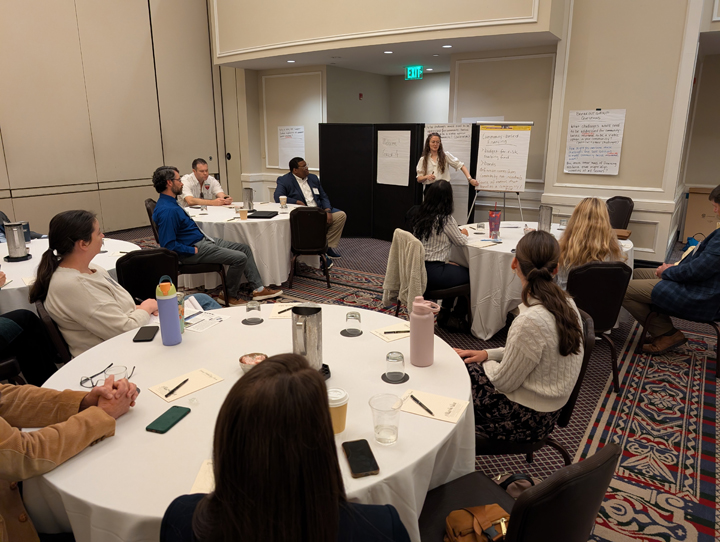
“A fantastic conference! The discussions on resilience finance were both timely and practical, especially the innovative approaches like parametric and community-based insurance, and the importance of planning grants,” said attendee Chris Stone, professional engineer emeritus. “It’s encouraging to see so many perspectives focused on empowering Virginia’s state and local governments to lead the way on resilience. These conversations are exactly what we need to secure our future.”
The afternoon panel addressed questions and issues raised during previous sessions, especially during the breakout sessions. Those that shared their knowledge and expertise during the afternoon panel included Elizabeth Andrews, distinguished law & policy fellow at UVA’s Institute for Engagement & Negotiation; Lewie Lawrence, managing director, Middle Peninsula Planning District Commission; Ben McFarlane, chief resilience officer, Hampton Roads Planning District Commission; Matt Simons, deputy resilience officer, City of Norfolk; and Emily Steinhilber, director of climate resilient coasts & watersheds in Virginia, who is part of the Environmental Defense Fund and also served as the afternoon panel’s moderator.
The afternoon panel gave credence to just how complex this topic is, introducing the need for balance between effective long-term planning for growing risk and quick solutions to protect and recover from imminent disaster. The panel highlighted the urgent call for alignment between community need and industry markets.
When taken in the context of the morning panel’s topics, the notions of collective responsibility and public-private partnerships as mechanisms for risk mitigation and stabilization of funding streams emerged as core themes from the day’s proceedings.
In line with the complexity of resilience issues, the breakout groups also identified additional issues that were not able to be addressed in the afternoon but will form part of the future work of the VCRC. These included how to best organize the multitude of actors in the resilience space to foster effective action; how to address current and potential development in risky areas; normative and governance questions about where, how, and why tax dollars are spent at the local level; and the challenges of generating sufficient knowledge and participation of the public that benefits from and pays for resilience actions.
Of course, relationships with Virginia’s coastal neighbors are essential as well, and attendees from beyond Virginia expressed gratitude for the event.
“As a North Carolina resilience professional, it was an easy choice to make the trip to the VCRC conference,” said William Ferris of Duke University. “Interstate connections driving innovative thinking and alignment are crucial for comprehensive coastal resilience, and I feel the conference attracted the right attendees to really bring us forward as an industry.”
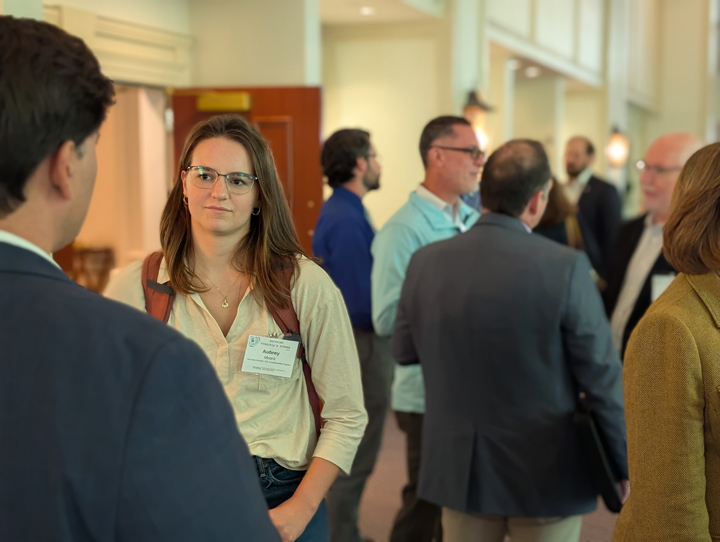
With new connections forged, ideas sparked and continuing pathways for resilience revealed, the spirit of collaboration was alive and well at “Securing Virginia’s Future.” Organizers and attendees alike left the day energized to continue the work in their field and assuredly look forward to future iterations of the conference.
“The purpose of today’s topic and structure was not necessarily to identify solutions to all questions of Virginia’s resilience, but to promote cross-sectoral conversations around a topic that does not always get as much attention as adaptive design and climate modeling,” remarked Ruppert. “The hope was that attendees would leave with options for collaborating and partnering, creating momentum that will drive future avenues for discussion, and we accomplished that today.”
The VCRC will continue to convene partners from across Virginia’s resilience space each fall and plans to host its second all-day symposium in October 2026.
Latest W&M News
- On the prowl for owlsWilliam & Mary researchers investigate how the barred owl is adapting to urbanization.
- Fair highlights vibrant campus research communityThe third annual Undergraduate Research Opportunities Fair drew a record crowd to Sadler Center's Chesapeake Room Oct. 15, with more than 270 students exploring the expansive array of multidisciplinary research opportunities available on campus.
- A picture-perfect HomecomingThousands of alumni and W&M community members returned to campus for more than 120 events during Homecoming & Reunion Weekend 2025.
- Celebrate together: Homecoming 2025William & Mary's community gathered Oct. 16-19 for the annual Homecoming & Reunion Weekend.
- Spooky artifacts haunt Swem Library’s Special Collections for HalloweenThe Special Collections Research Center will be packed on Oct. 30 with Halloween-themed items dating as far back as the 18th century.
- Journalist, author David Sanger selected as W&M’s Hunter B. Andrews FellowAward-winning journalist and author David E. Sanger will visit William & Mary in November as the university’s 2025 Hunter B. Andrews Fellow.



